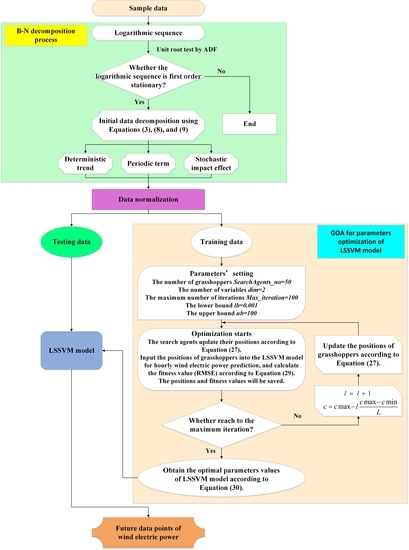Short-Term Wind Electric Power Forecasting Using a Novel Multi-Stage Intelligent Algorithm
Abstract
:1. Introduction
2. Materials and Methods
2.1. The Item to Be Shipped and the Shipping Method
2.2. Target Area and Shipping Distance
2.3. Life Cycle Analysis (LCA)
3. Results and Discussion
3.1. Comparison of the Environmental Impacts of Motorcycle Delivery and Drone Delivery
3.2. Comparison of GWP and the Effects of Particulate Reduction between Urban and Rural Areas
3.3. Comparison of the Reduction Effects between Urban and Rural Areas by Impact Category
3.4. Interpretation
3.4.1. Environmental Impact of Delivery Using Electric Motorcycles
3.4.2. Comparison of the Drones’ Reduction Effect According to the National Power Generation Scheme
3.4.3. Drones’ GHG Reduction Effect by Expanding Renewable Energy
4. Conclusions
Acknowledgments
Author Contributions
Conflicts of Interest
References
- Evans, M. Future war in cities: Urbanization’s challenge to strategic studies in the 21st century. Int. Rev. Red Cross 2016, 98, 37–51. [Google Scholar] [CrossRef]
- Zhou, K.; Liu, T.; Zhou, L. Industry 4.0: Towards future industrial opportunities and challenges. In Proceedings of the 2015 12th International Conference on Fuzzy Systems and Knowledge Discovery (FSKD), Zhangjiajie, China, 15–17 August 2015; pp. 2147–2152. [Google Scholar]
- Smith, K.W. Drone technology: Benefits, risks, and legal considerations. Seattle J. Environ. L. 2015, 5, 290–302. [Google Scholar]
- Xu, J.-F. An Innovative Technology of Distributed Control System Integration for Unmanned Aerial Vehicles. Acta Simul. Syst. Sin. 2003, 3. Available online: http://en.cnki.com.cn/Article_en/CJFDTOTAL-XTFZ200303037.htm (accessed on 19 March 2018).
- Commercial, U.A.V. Commercial Drone Market Analysis By Product (Fixed Wing, Rotary Blade, Nano, Hybrid), by Application (Agriculture, Energy, Government, Media & Entertainment) and Segment Forecasts to 2022; Grand View Research: San Francisco, CA, USA, 2016. [Google Scholar]
- Murray, C.C.; Chu, A.G. The flying sidekick traveling salesman problem: Optimization of drone-assisted parcel delivery. Trans. Res. Emerg. Technol. 2015, 54, 86–109. [Google Scholar] [CrossRef]
- Nex, F.; Remondino, F. Uav for 3D mapping applications: A review. Appl. Geomat. 2014, 6, 1–15. [Google Scholar] [CrossRef]
- Lee, S.H.; Lee, S.; Song, H.; Lee, H.S. Wireless sensor network design for tactical military applications: Remote large-scale environments. In Proceedings of the MILCOM 2009 Military Communications Conference, Boston, MA, USA, 18–21 October 2009; pp. 1–7. [Google Scholar]
- Springer, P.J. Military Robots and Drones: A Reference Handbook; ABC-CLIO: Santa Barbara, CA, USA, 2013. [Google Scholar]
- Haidari, L.A.; Brown, S.T.; Ferguson, M.; Bancroft, E.; Spiker, M.; Wilcox, A.; Ambikapathi, R.; Sampath, V.; Connor, D.L.; Lee, B.Y. The economic and operational value of using drones to transport vaccines. Vaccine 2016, 34, 4062–4067. [Google Scholar] [CrossRef] [PubMed]
- Boccardo, P.; Chiabrando, F.; Dutto, F.; Tonolo, F.G.; Lingua, A. UAV deployment exercise for mapping purposes: Evaluation of emergency response applications. Sensors 2015, 15, 15717–15737. [Google Scholar] [CrossRef] [PubMed]
- Bravo, R.; Leiras, A. Literature review of the application of UAVs in humanitarian relief. In Proceedings of the XXXV Encontro Nacional de Engenharia de Producao, Fortaleza, Brazil, 13–16 October 2015; pp. 13–16. [Google Scholar]
- Heutger, M. Unmanned Aerial Vehicle in Logistics. In A DHL Perspective on Implications and Use Cased for the Logistics Industry; DronesX Media LLC: Burbank, CA, USA, 2014. [Google Scholar]
- Wilkinson, P.; Cole, D. The role of radio science in disaster management. URSI Radio Sci. Bull. 2010, 83, 45–51. [Google Scholar]
- Welch, A. A Cost-Benefit Analysis of Amazon Prime Air. Bachelor’s Thesis, University of Tennessee at Chattanooga, Chattanooga, TN, USA, 2015. [Google Scholar]
- Pandit, V.; Poojari, A. A study on amazon prime air for feasibility and profitability: A graphical data analysis. IOSR J. Bus. Manag. 2014, 16, 6–11. [Google Scholar] [CrossRef]
- Mohammed, F.; Idries, A.; Mohamed, N.; Al-Jaroodi, J.; Jawhar, I. UAVs for smart cities: Opportunities and challenges. In Proceedings of the 2014 International Conference on Unmanned Aircraft Systems (ICUAS), Orlando, FL, USA, 27–30 May 2014; pp. 267–273. [Google Scholar]
- Bamburry, D. Drones: Designed for product delivery. Des. Manag. Rev. 2015, 26, 40–48. [Google Scholar]
- Pepitone, J. Domino’s Tests Drone Pizza Delivery. CNNMoney. 4 June 2013. Available online: http://money.cnn.com/2013/06/04/technology/innovation/dominos-pizza-drone/index.html (accessed on 19 March 2018).
- Javaid, A.; Sun, W.; Alam, M. Uavnet simulation in uavsim: A performance evaluation and enhancement. In Proceedings of the International Conference on Testbeds and Research Infrastructures, Guangzhou, China, 5–7 May 2014; Springer: Berlin, Germany, 2014; pp. 107–115. [Google Scholar]
- Agatz, N.; Bouman, P.; Schmidt, M. Optimization Approaches for the Traveling Salesman Problem with Drone; Elsevier: Amsterdam, The Netherlands, 2016. [Google Scholar]
- Carlsson, J.G.; Song, S. Coordinated logistics with a truck and a drone. Manag. Sci. 2017. [Google Scholar] [CrossRef]
- Choi, Y.; Schonfeld, P.M. Optimization of multi-package drone deliveries considering battery capacity. In Proceedings of the 96th Annual Meeting of the Transportation Research Board, Washington, DC, USA, 8–12 January 2017. [Google Scholar]
- Clarke, R.; Moses, L.B. The regulation of civilian drones’ impacts on public safety. Comput. Law Secur. Rev. 2014, 30, 263–285. [Google Scholar] [CrossRef]
- Clarke, R. The regulation of civilian drones’ impacts on behavioural privacy. Comput. Law Secur. Rev. 2014, 30, 286–305. [Google Scholar] [CrossRef]
- Rao, B.; Gopi, A.G.; Maione, R. The societal impact of commercial drones. Technol. Soc. 2016, 45, 83–90. [Google Scholar] [CrossRef]
- Jones, T. International Commercial Drone Regulation and Drone Delivery Services; RR-1718/3-RC; RAND Corporation: Santa Monica, CA, USA, 2017. [Google Scholar]
- Stolaroff, J. The Need for a Life Cycle Assessment of Drone-Based Commercial Package Delivery; Lawrence Livermore National Laboratory (LLNL): Livermore, CA, USA, 2014. [Google Scholar]
- Goodchild, A.; Toy, J. Delivery by drone: An evaluation of unmanned aerial vehicle technology in reducing CO2 emissions in the delivery service industry. Transp. Res. Part D Transp. Environ. 2017. [Google Scholar] [CrossRef]
- Figliozzi, M.A. Lifecycle modeling and assessment of unmanned aerial vehicles (drones) CO2 e emissions. Transp. Res. Transp. Environ. 2017, 57, 251–261. [Google Scholar] [CrossRef]
- Lohn, A.J. What’s the Buzz? The City-Scale Impacts of Drone Delivery; RAND Corporation: Santa Monica, CA, USA, 2017. [Google Scholar] [CrossRef]
- Kim, H. A Study on the main Status of Environment Logistics and Expansion Strategy in Korea. J. Korea Port Econ. Assoc. 2009, 25. Available online: http://ocean.kisti.re.kr/IS_mvpopo001P.do?method=multMain&poid=tkpea&kojic=OMGJBU&free= (accessed on 19 March 2018).
- Kwon, J.; Kim, S.; Park, E.; Song, J. A study on the number of domestic food delivery services. Korean J. Appl. Stat. 2015, 28, 977–990. [Google Scholar] [CrossRef]
- Kim, S.; Kim, T.; Suh, K. Analysis of the implication of accessibility to community facilities for land price in rural areas using a hedonic land price model. J. Korean Soc. Rural Plan. 2016, 22, 93–100. [Google Scholar] [CrossRef]
- Kim, T.; Shin, Y.; Lee, J.; Suh, K. Calculation of regional circuity factors using road network distance in South Korea. J. Korea Plan. Assoc. 2013, 48, 319–329. [Google Scholar]
- Wolf, M.-A.; Chomkhamsri, K.; Brandao, M.; Pant, R.; Ardente, F.; Pennington, D.W.; Manfredi, S.; de Camillis, C.; Goralczyk, M. ILCD Handbook—General Guide for Life Cycle Assessment-Detailed Guidance; Joint Research Centre: City of Brussels, Belgium, 2010. [Google Scholar]
- ISO (International Organization for Standardization). ISO 14043: Environmental Management—Life Cycle Interpretation; International Organization for Standardization: Geneva, Switzerland, 1998. [Google Scholar]
- NREL (National Renewable Energy Laboratory). U.S. Life Cycle Inventory Database; National Renewable Energy Laboratory: Lakewood, CO, USA, 2012. [Google Scholar]
- KEITI (Korea Environmental Industry & Technology Institute). Life Cycle Assessment Software (TOTAL) Manual for eco Labeling; Korea Environmental Industry & Technology Institute (KEITI): Seoul, Korea, 2000. [Google Scholar]
- Kil, B.-S.; Kim, G.-C. The analysis of a electric scooter’s performance through motor and battery capacity changing. Trans. Korean Soc. Automot. Eng. 2011, 19, 7–13. [Google Scholar]
- Burkhardt, J.J.; Heath, G.; Cohen, E. Life cycle greenhouse gas emissions of trough and tower concentrating solar power electricity generation. J. Ind. Ecol. 2012, 16. [Google Scholar] [CrossRef]
- Hsu, D.D.; O’Donoughue, P.; Fthenakis, V.; Heath, G.A.; Kim, H.C.; Sawyer, P.; Choi, J.K.; Turney, D.E. Life cycle greenhouse gas emissions of crystalline silicon photovoltaic electricity generation. J. Ind. Ecol. 2012, 16. [Google Scholar] [CrossRef]
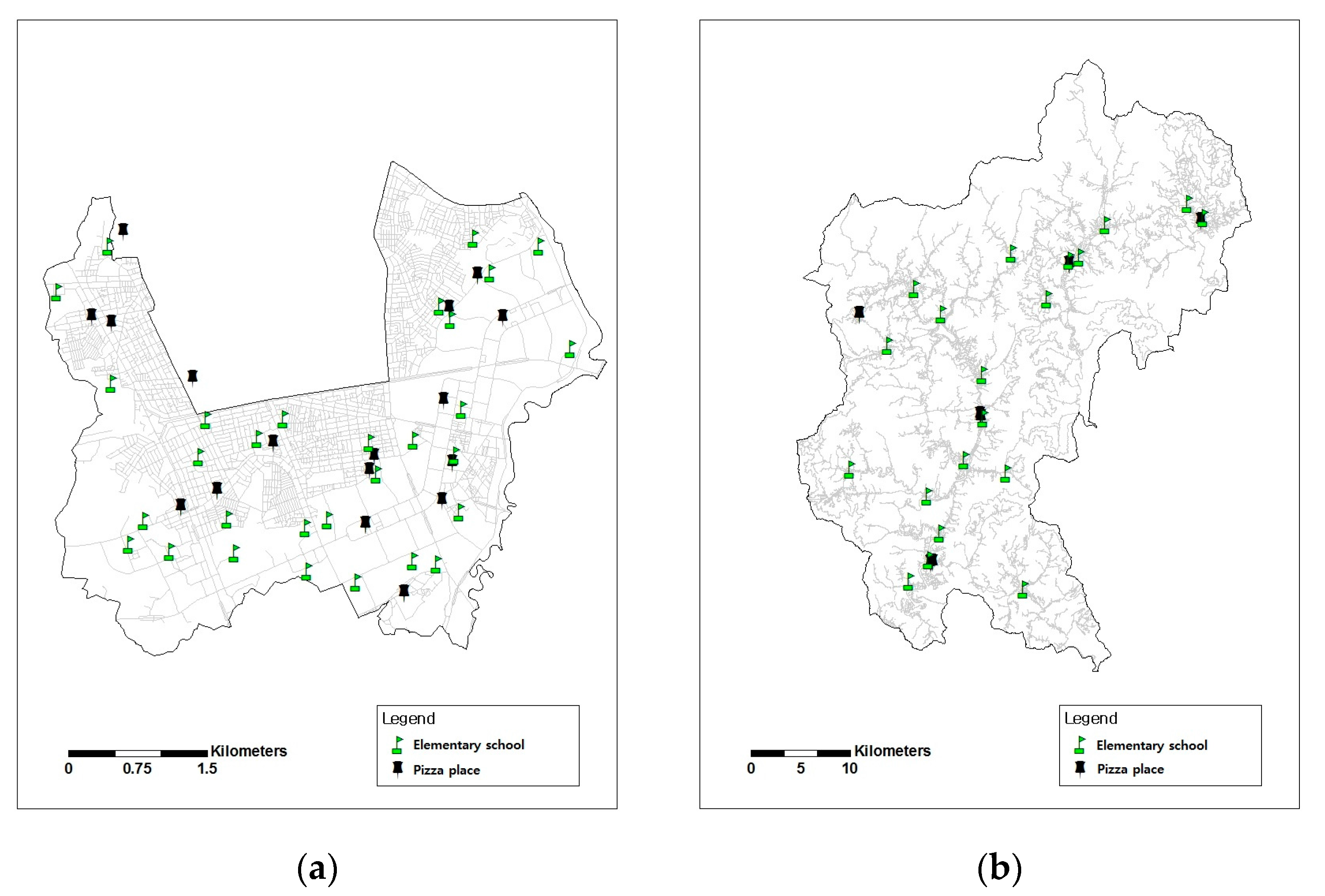
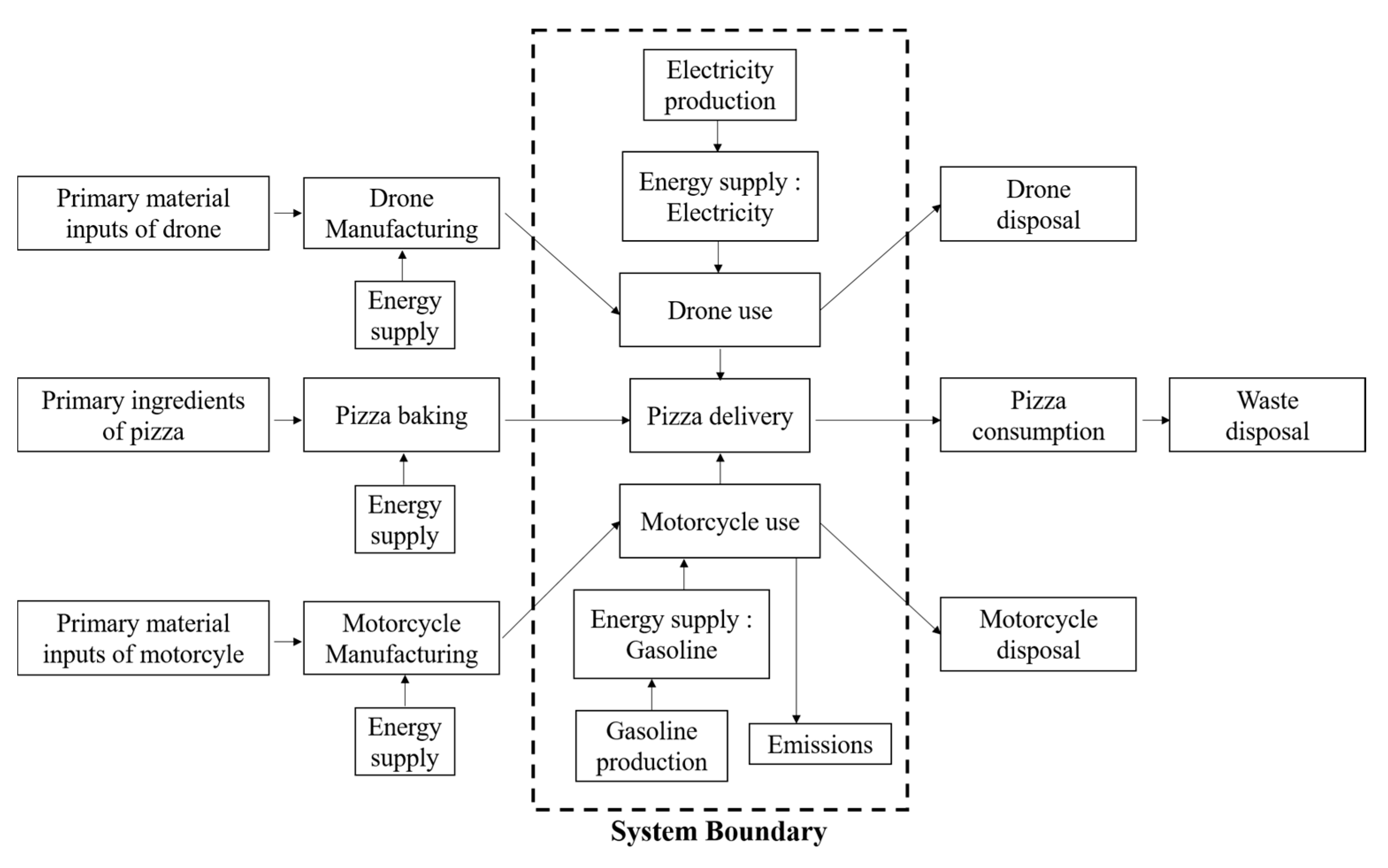
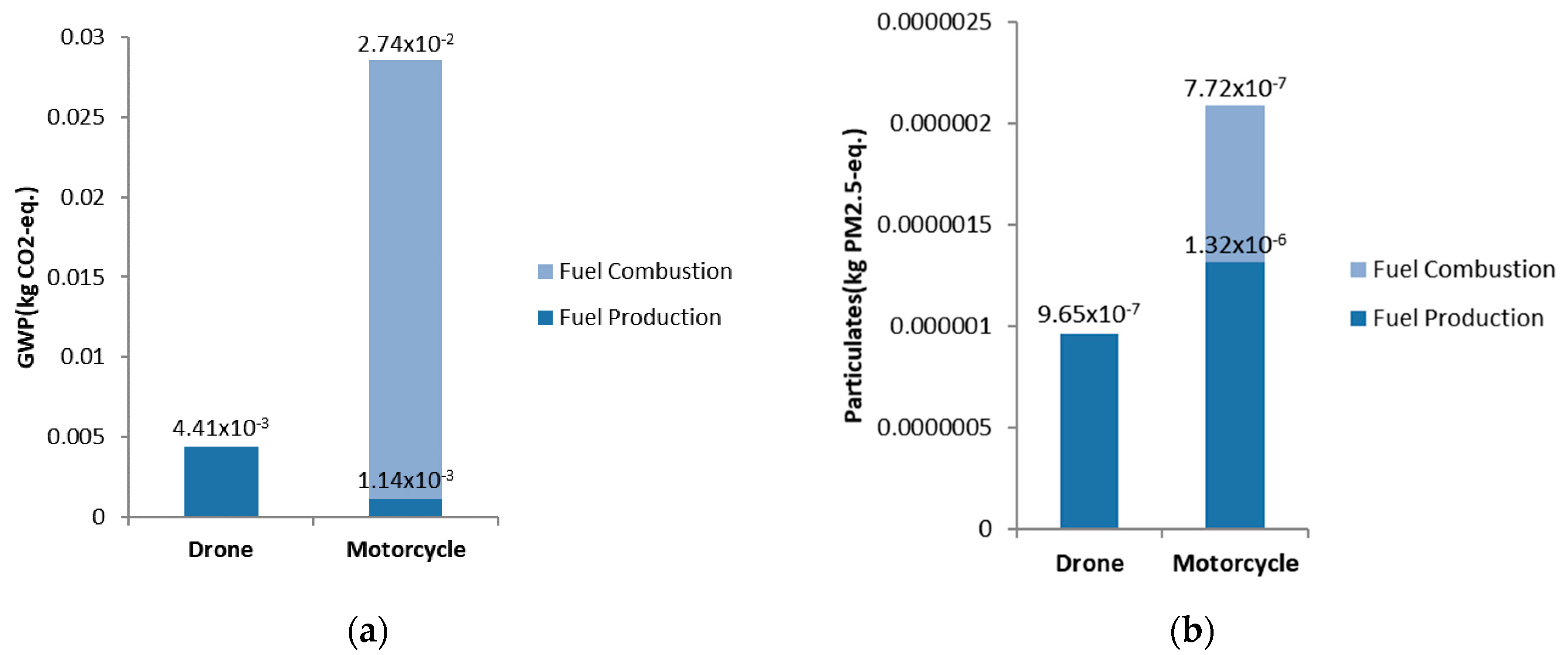
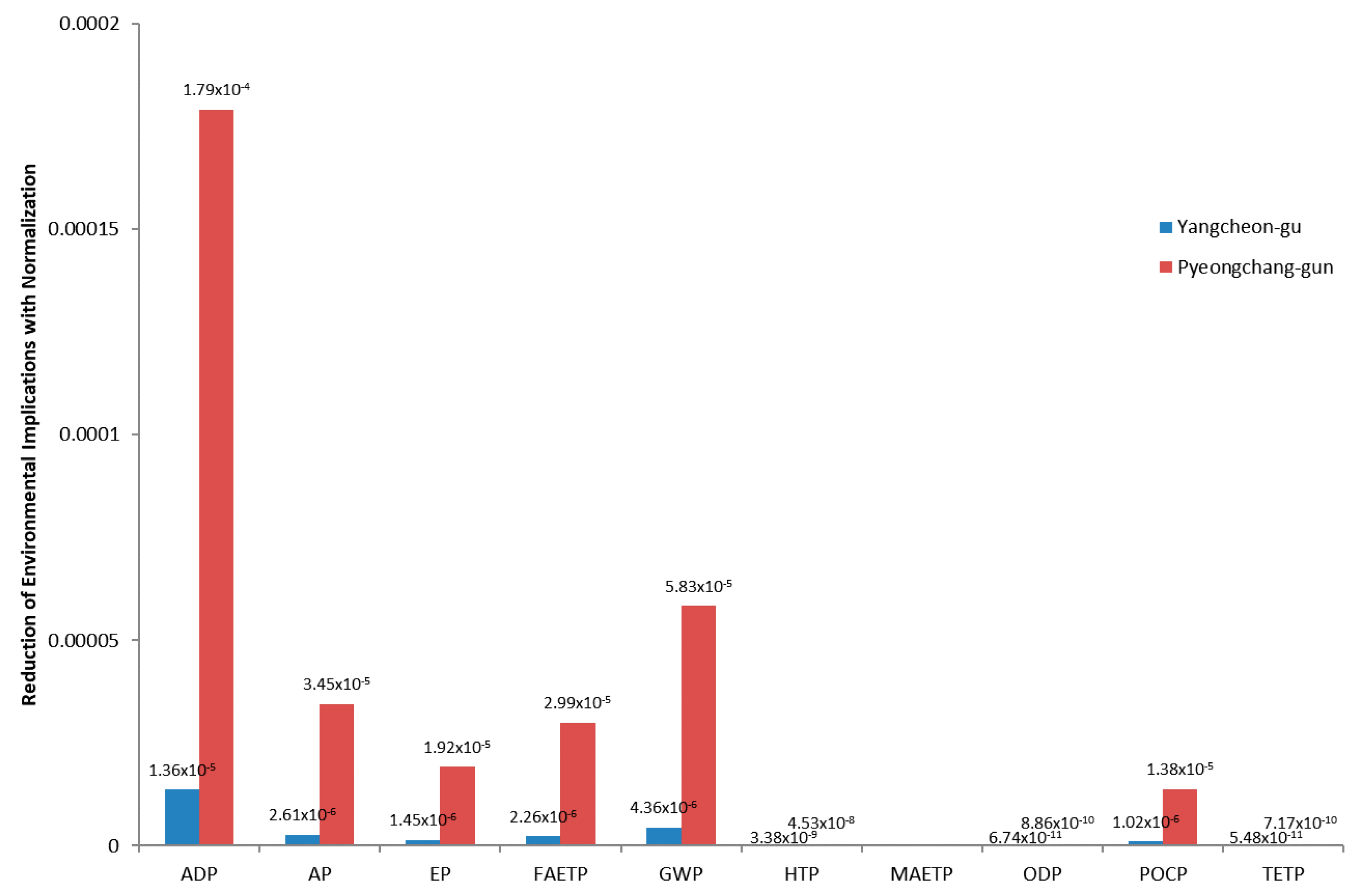
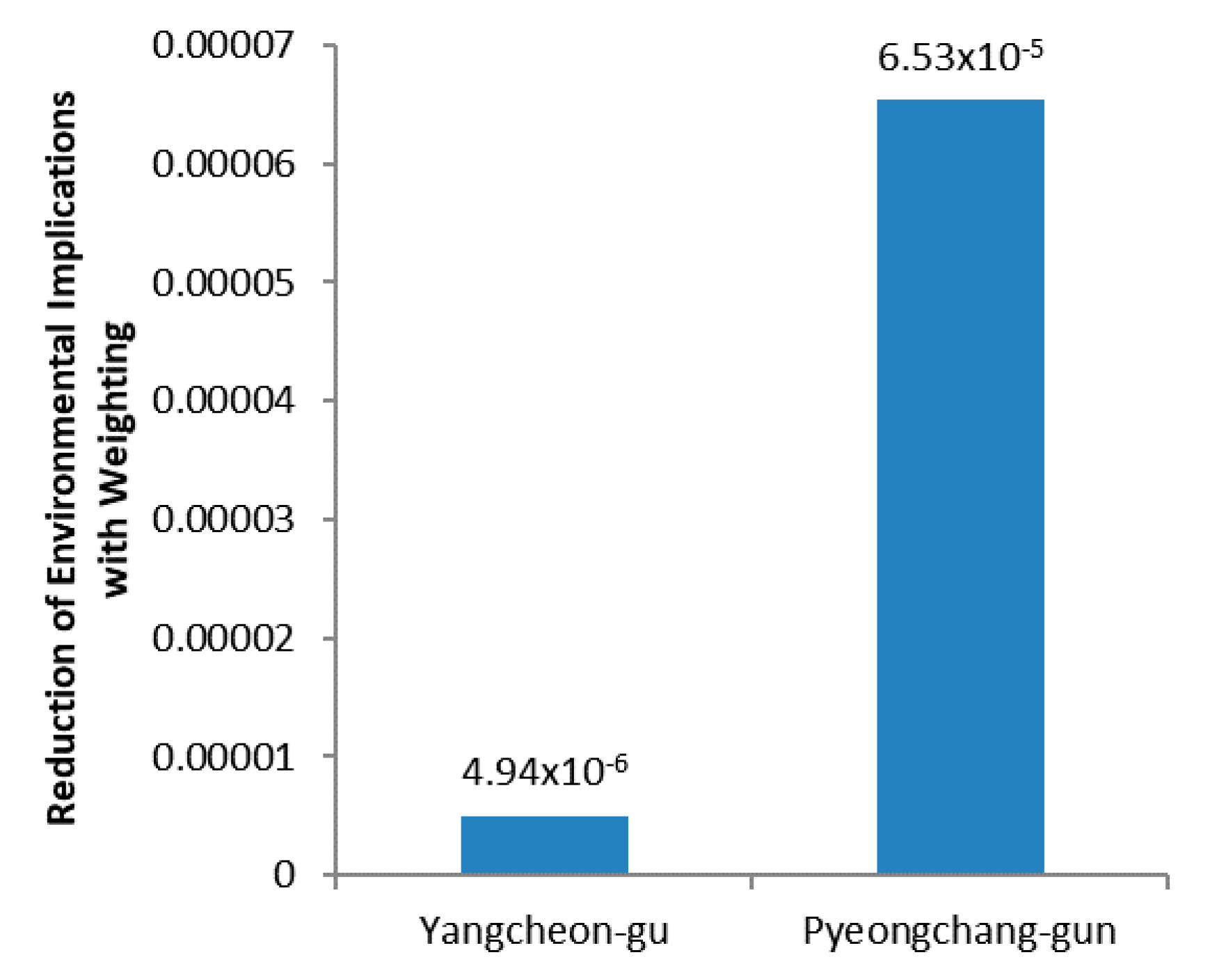

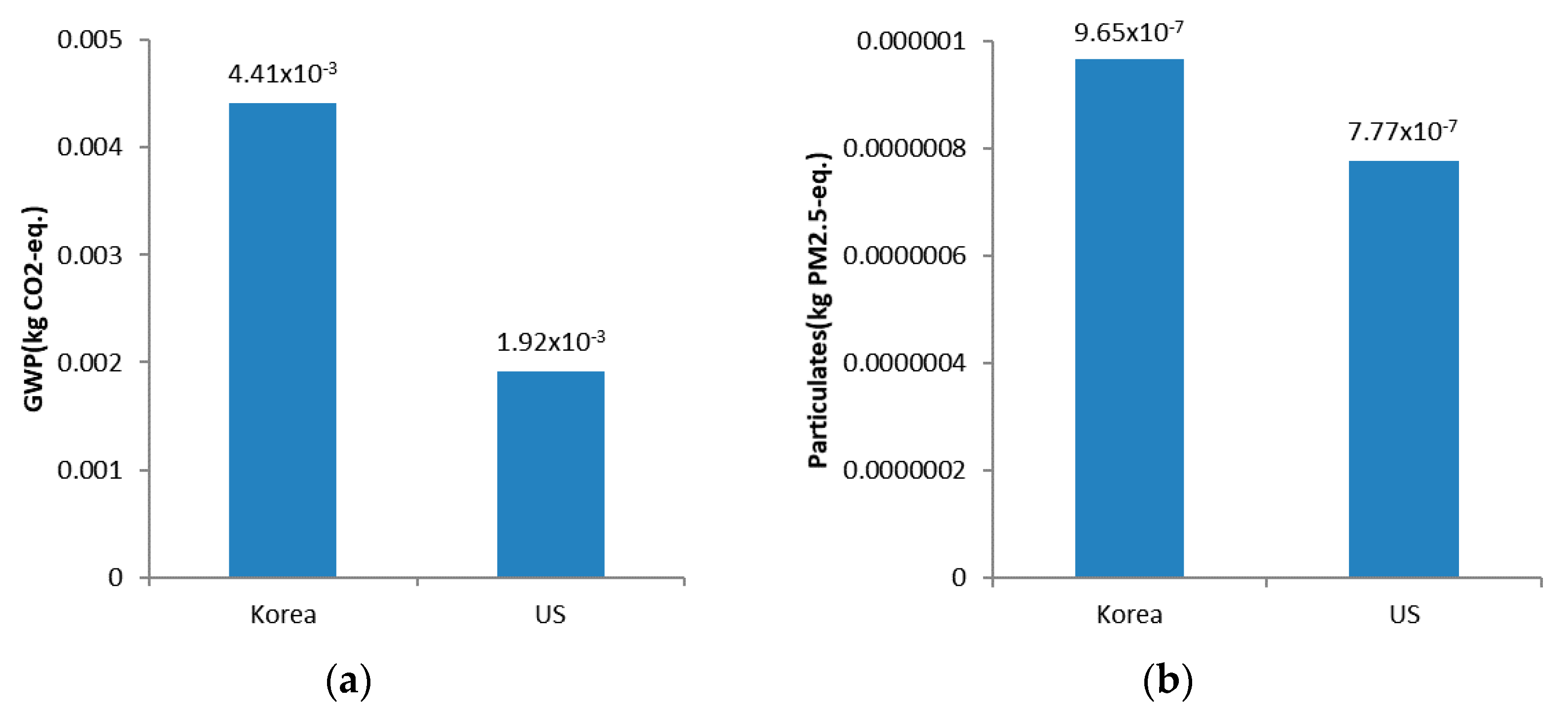
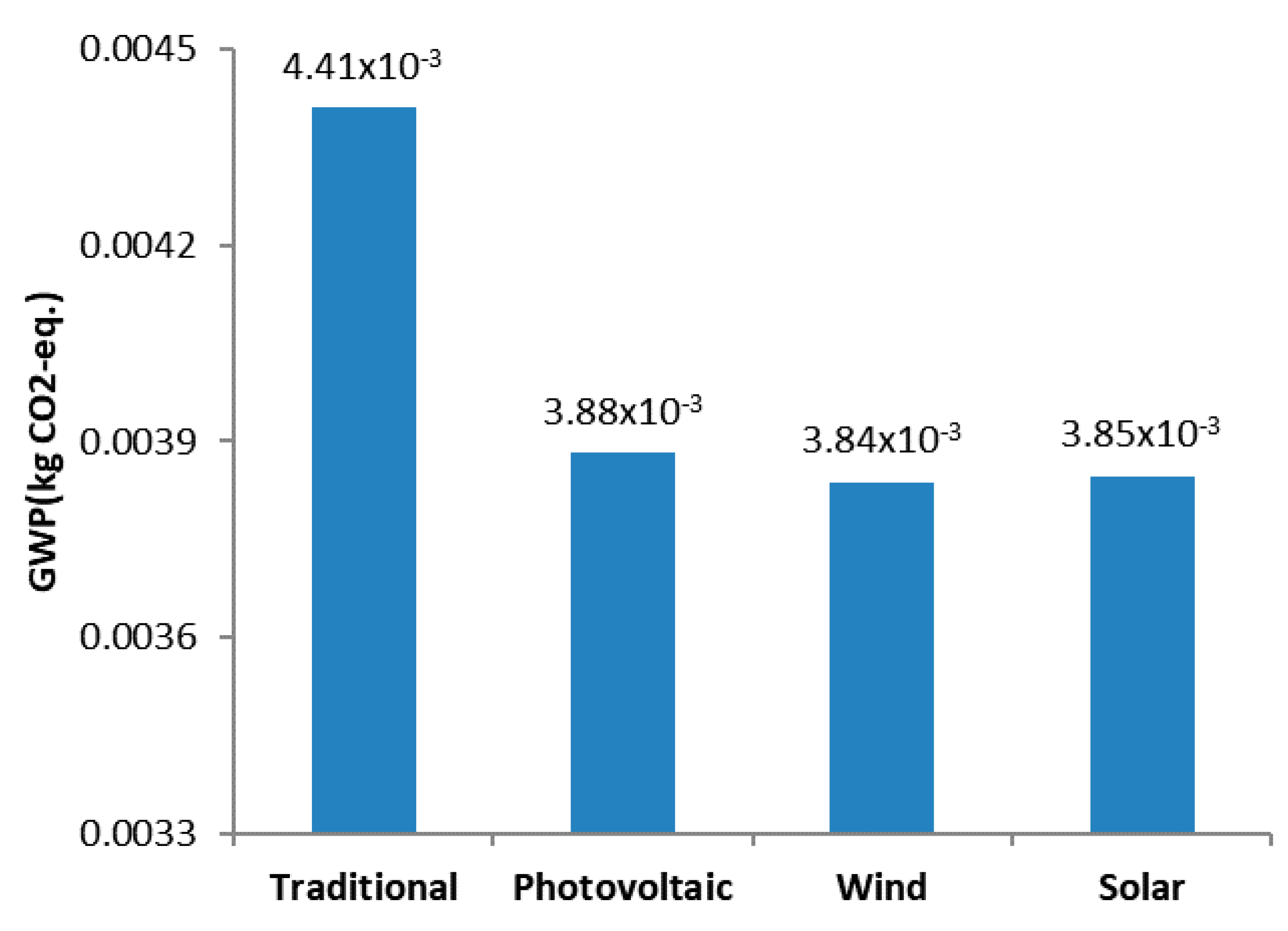
| Impact Category | Unit | |
|---|---|---|
| ADP | Abiotic Depletion Potential | 1/year |
| AP | Acidification Potential | kg SO2-eq |
| EP | Eutrophication Potential | kg PO43−-eq |
| FAETP | Freshwater Aquatic Ecotoxicity Potential | kg 1,4 DCB-eq. |
| GWP | Global Warming Potential | kg CO2-eq. |
| HTP | Human Toxicity Potential | kg 1,4 DCB-eq. |
| MAETP | Marine Aquatic Ecotoxicity Potential | kg 1,4 DCB-eq. |
| ODP | Ozone Depletion Potential | kg CFC11-eq. |
| POCP | Photochemical Oxidants Creation Potential | kg ethylene-eq. |
| TETP | Terrestrial Ecotoxicity Potential | kg 1,4 DCB-eq. |
| PM2.5 | Particulates Matter | kg PM2.5-eq. |
| Category | Unit | Characterization | Normalization | Weighting |
|---|---|---|---|---|
| ADP | 1/year | 1.54 × 10−5 | 6.17 × 10−7 | 4.37 × 10−7 |
| AP | kg SO2-eq./kg | 7.46 × 10−6 | 1.87 × 10−7 | |
| EP | kg PO43−-eq./kg | 1.39 × 10−6 | 1.06 × 10−7 | |
| FAETP | kg 1,4 DCB eq./kg | 3.14 × 10−7 | 2.10 × 10−7 | |
| GWP | kg CO2-eq./kg | 4.41 × 10−3 | 7.97 × 10−7 | |
| HTP | kg 1,4 DCB eq./kg | 9.86 × 10−7 | 6.66 × 10−10 | |
| MAETP | kg 1,4 DCB eq./kg | 2.25 × 10−3 | 2.90 × 10−8 | |
| ODP | kg CFC 11-eq./kg | 1.02E × 10−13 | 2.49 × 10−12 | |
| POCP | kg ethylene eq./kg | 3.05 × 10−6 | 2.97 × 10−7 | |
| TETP | kg 1,4 DCB eq./kg | 1.78 × 10−13 | 1.09 × 10−13 |
| Category | Unit | Characterization | Normalization | Weighting |
|---|---|---|---|---|
| ADP | 1/year | 3.62 × 10−4 | 1.46 × 10−5 | 5.46 × 10−6 |
| AP | kg SO2-eq./kg | 1.13 × 10−4 | 2.85 × 10−6 | |
| EP | kg PO43−-eq./kg | 2.08 × 10−5 | 1.59 × 10−6 | |
| FAETP | kg 1,4 DCB eq./kg | 3.76 × 10−6 | 2.50 × 10−6 | |
| GWP | kg CO2-eq./kg | 2.85 × 10−2 | 5.16 × 10−6 | |
| HTP | kg 1,4 DCB eq./kg | 5.98 × 10−6 | 4.04 × 10−9 | |
| MAETP | kg 1,4 DCB eq./kg | 4.31 × 10−4 | 5.56 × 10−9 | |
| ODP | kg CFC 11-eq./kg | 2.92 × 10−12 | 7.17 × 10−11 | |
| POCP | kg ethylene eq./kg | 1.34 × 10−5 | 1.30 × 10−6 | |
| TETP | kg 1,4 DCB eq./kg | 9.24 × 10−11 | 5.67 × 10−11 |
| Nations | Coal | Petroleum | Gas | Nuclear | Hydraulic | Renewable |
|---|---|---|---|---|---|---|
| Korea | 40.3 | 5.0 | 20.5 | 31.1 | 0.7 | 2.5 |
| US | 43.3 | 0.9 | 24.2 | 19.0 | 7.4 | 5.2 |
| Germany | 45.1 | 1.1 | 13.9 | 17.9 | 2.9 | 19.1 |
| France | 3.1 | 0.6 | 4.8 | 79.4 | 8.0 | 4.0 |
| Japan | 27.0 | 14.7 | 35.9 | 9.8 | 8.0 | 4.7 |
| China | 78.9 | 0.2 | 2.0 | 1.8 | 14.7 | 2.4 |
© 2018 by the authors. Licensee MDPI, Basel, Switzerland. This article is an open access article distributed under the terms and conditions of the Creative Commons Attribution (CC BY) license (http://creativecommons.org/licenses/by/4.0/).
Share and Cite
Zhao, H.; Zhao, H.; Guo, S. Short-Term Wind Electric Power Forecasting Using a Novel Multi-Stage Intelligent Algorithm. Sustainability 2018, 10, 881. https://doi.org/10.3390/su10030881
Zhao H, Zhao H, Guo S. Short-Term Wind Electric Power Forecasting Using a Novel Multi-Stage Intelligent Algorithm. Sustainability. 2018; 10(3):881. https://doi.org/10.3390/su10030881
Chicago/Turabian StyleZhao, Haoran, Huiru Zhao, and Sen Guo. 2018. "Short-Term Wind Electric Power Forecasting Using a Novel Multi-Stage Intelligent Algorithm" Sustainability 10, no. 3: 881. https://doi.org/10.3390/su10030881
APA StyleZhao, H., Zhao, H., & Guo, S. (2018). Short-Term Wind Electric Power Forecasting Using a Novel Multi-Stage Intelligent Algorithm. Sustainability, 10(3), 881. https://doi.org/10.3390/su10030881



